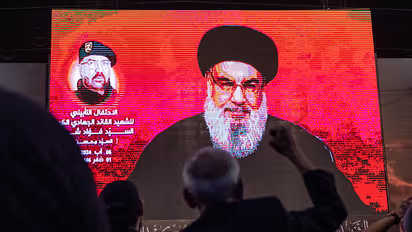Hassan Nasrallah: A Profile of Hezbollah's Fallen Secretary-General

Synopsis
Since the Hamas attack on October 7 and the ongoing Israeli conflict in Gaza, Hezbollah, which is labeled as a terrorist group by the US and several other countries, has been involved in intense cross-border fighting with Israel to show support for Gaza.
After many years of leading Hezbollah and guiding its growth in Lebanon and across the region, Secretary-General Hassan Nasrallah was killed in an Israeli attack in Beirut. Hassan Nasrallah, the influential leader of Hezbollah, was killed in a major Israeli strike on Friday , 27th September, in the southern suburbs of Beirut, the capital of Lebanon. This event marks a serious setback for the group.
Both Hezbollah and Israel confirmed on Saturday, September 28th, that Nasrallah had died.
Nasrallah, aged 64, had been leading the Shiite paramilitary group since 1992.
Since the Hamas attack on October 7 and the ongoing Israeli conflict in Gaza, Hezbollah, which is labeled as a terrorist group by the US and several other countries, has been involved in intense cross-border fighting with Israel to show support for Gaza.
Who was Nasrallah?
Nasrallah was born in August 1960 to a low-income family in the Burj Hammoud area, located in eastern Beirut.
He was the oldest of nine children, and his father is said to have run a small vegetable stall to make a living.
Nasrallah grew up in a mostly Christian neighborhood, but when the Lebanese civil war began in 1975, his family escaped to the village of Bazourieh, near the southern city of Tyre.
In Bazourieh, Nasrallah finished his high school education and, for a short time, became a member of the Amal Movement, a Shiite political organization.
Between 1976 and 1978, Nasrallah was in Najaf, Iraq, where he studied the Quran.
However, due to the Sunni Baath party’s harsh treatment of Shiites in Iraq at that time, Nasrallah had to return to Lebanon. He later went to Iran and finished his studies there in 1989.
Nasrallah married Fatima Yassin in 1978, and they had five children together. One of his sons, Hadi, was killed in an Israeli ambush in southern Lebanon at the age of 18 in 1997.
Rise of Nasrallah
Nasrallah was 22 years old when Hezbollah was established in 1982 by a group of Shiite clerics and supporters of Iran’s Ayatollah Ruhollah Khomeini. The group was formed to resist Israel’s second invasion of Lebanon.
Shortly after Hezbollah was founded, Nasrallah joined the group and took on various roles over the years, including leading Hezbollah in the Bekaa region and in Beirut.
In 1992, Nasrallah became the leader of Hezbollah, taking over from Abbas al-Musawi, who was killed in a missile strike by Israeli helicopters that targeted his convoy in southern Lebanon.
Under Nasrallah's leadership, Hezbollah, with strong support from Iran, grew from a small militia into a large paramilitary force and a key political power in Lebanon.
Today, Hezbollah is thought to have between 50,000 and 100,000 fighters, with an arsenal estimated to include around 150,000 to 200,000 rockets, mortar bombs, and missiles.
In October 2021, Nasrallah stated that his powerful group had 100,000 "trained" and "armed" fighters ready to serve.
Nasrallah became well-known after Israel withdrew from southern Lebanon in 2000. He was also instrumental in a significant prisoner exchange in 2004 between Hezbollah and Israel, where hundreds of Hezbollah members, Palestinians, and other Arabs held by Israel were freed in return for four Israelis.
Nasrallah further strengthened his position by declaring a "divine victory" over Israel after the 34-day war in July 2006.The war resulted in at least 1,190 deaths in Lebanon and forced nearly 900,000 people to flee their homes, while much of the country’s infrastructure was heavily damaged.In Israel, at least 160 people, including both civilians and soldiers, lost their lives.
Over the past decade, Hezbollah has grown into one of Iran's main proxy forces in the region, receiving weapons, training, and financial support from the Islamic Republic.Hezbollah sent fighters to Syria to support President Bashar al-Assad's forces during the Syrian civil war and also to Yemen to assist the Houthi rebels.
Hezbollah began firing rockets at Israel on October 8, 2023, just a day after the Israel-Hamas war started in the Gaza Strip.In a November speech, Nasrallah stated that the fight against Israel was in support of Hamas and the Palestinian people, promising to keep fighting until the war in Gaza is over.
Nasrallah has repeated this commitment in his speeches over the past few months. In his most recent speech last week, following the explosions of a pager and walkie-talkie in Lebanon, he said, "The resistance in Lebanon will continue to support and help the people of Gaza, the West Bank, and all those who are oppressed."
Nasrallah, often seen as charismatic, had strong support from Shiites in Lebanon and other Arab countries with Shiite populations, such as Syria, Yemen, and Iraq.
He frequently gave passionate speeches during conflicts and wars, rallying his supporters.
Nasrallah has been in hiding for many years, fearing an Israeli assassination.Reports say that he moves under tight security to a central bunker for meetings with his group's members or other officials.
Stay updated with the Breaking News Today and Latest News from across India and around the world. Get real-time updates, in-depth analysis, and comprehensive coverage of India News, World News, Indian Defence News, Kerala News, and Karnataka News. From politics to current affairs, follow every major story as it unfolds. Download the Asianet News Official App to stay informed anytime, anywhere.